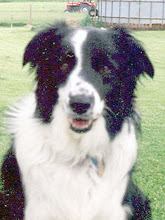The husband was en route to an 8-day vacation in Canada when I got the news: Dewey Kitty was to take antibiotics twice a day for the next 10 days.
I would have to find some way to get 1.5 ml of pink, sticky liquid down his throat.
He was unsuspecting the first time, when I wrapped him in a towel and squirted it down his throat.
The second time he was ready. I've seen the way you wrap Christmas presents and you have no tape, he said, extracting a claws-extended back paw that gave me a few scratches before I got the medicine down.
The third time, I thought about tape, but tried the double towel wrap. I'm smarter than that, he said, extricating a front paw, giving me a left hook and a head shake. Who knew 1.5 ml could fly so far? The towel, counter and walls were dotted in pink.
The solution came when I spotted Dewey Kitty curled up in a box.
I filled the syringe, petted him, listened to him purr. Then, with his feet tucked in the box, I opened his mouth and squirted the antibiotics in. No problem.
That evening, I pointed to his box, and he hopped in. I petted him for a bit, and administered the medication. No problem.
Sometimes it pays to think inside the box.
Sunday, August 12, 2018
Saturday, August 11, 2018
7 Years and 2 Nuts
Sometimes that moment of wonder is years in the making.
In the fall of 2011, I planted several buckeye nuts in the front yard. Maybe, just maybe, I'd have my own buckeyes in five years.
In the summer of 2012, I marveled at my baker's dozen of seedlings.
When the seedlings survived another year, I thinned them out and kept two: an heir and a spare.
This summer, I have my first harvest: two nuts.
They'll go in my pocket, I think, and be my lucky buckeyes.
In the fall of 2011, I planted several buckeye nuts in the front yard. Maybe, just maybe, I'd have my own buckeyes in five years.
In the summer of 2012, I marveled at my baker's dozen of seedlings.
When the seedlings survived another year, I thinned them out and kept two: an heir and a spare.
This summer, I have my first harvest: two nuts.
They'll go in my pocket, I think, and be my lucky buckeyes.
Wednesday, August 1, 2018
One Brain Cell
The ram lambs often move as a collective clump.
At four months of age, the ram lambs are separated from the flock and enter their state of bachelorhood. They live in a separate pasture, and graze, ruminate and sleep together.
The time spent on sheep care goes up.
Not only do we have to ensure the ram lambs are getting plenty of food and water, we also must deal with their erratic behavior.
For the most part, the flock of ewes and ewe lambs behave in a predictable manner. The lead ewe, often an older, wiser animal, makes the decisions about when the flock goes to pasture, when it worries about people, when it sleeps, and when it runs.
The ram lambs have no leader. Instead, they act as a collective clump that often makes bad decisions.
Sometimes they startle at the sight of a dog and go sprinting across the field. Sometimes they sprint, just because. Sometimes the group splits, and they stand in a state of wonder. How will they ever get back together?
The Border collies and I must practice lots of patience.
Tonight, when moving the ram lambs to another pasture, three lambs decided to dart into the waterway. Were they older ewes, I would have sent the dog to reunite the flock. Doing that with ram lambs may have sent the three on a suicide mission into the fence. So, I asked the dog to lie down and wait as the one-brain-celled group figured out how to reunite with the others.
Eventually they did.
But will they remember this lesson tomorrow?
I'm not counting on it.
The Border collies learn to keep their distance and to move slowly around ram lambs.
Subscribe to:
Posts (Atom)



















